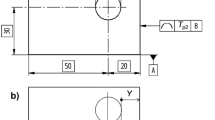Abstract
The tolerance chart is a graphical method for representing the manufacturing dimensions of a workpiece or assembly, at all stages of its manufacture. The chart provides an intermediate control system of checks and balances to ensure that processing dimensions and tolerances will meet those specified on the print. Tolerance charts are generally used in studying the dimensional problems on individual parts. However, they have proved tedious in their application to assemblies. This paper presents a simple and systematic approach to the process of tolerance stack analysis. The “Noded graph” model is constructed, representing the given and the unknown dimensions. Links are then established, using the model, which help to formulate the stack path of interest into a linear equation. The equation is used to complete the tolerance stack analysis module. This will be explained using a variety of geometric dimensioning and tolerancing examples. In addition, it is simple and hence easy to practise and very logical.
Similar content being viewed by others
References
R. S. Ahluwalia and A. V. Karolin, “CATC — a computer aided tolerance control system”, Journal of Manufacturing Systems, 3(2), pp. 153–160, 1984.
D. Fainguelernt, D. Weill and P. Bourdet, “Computer aided tolerancing and dimensioning in process planning”, Annals CIRP, 35(1), pp. 381–386, 1986.
X.-Q. Tang and B. J. Davies, “Computing aided dimensioning planning”, International Journal of Production Research, 26(2), pp. 283–297, 1988.
K. Whybrew, G. A. Britton, G. P. Robinson and Y. Sermsuti-Anuwat, “A graph-theoretic approach to tolerance charting”, International Journal of Advanced Manufacturing Technology, 5(2), pp. 175–183, 1990.
B. K. A. Ngoi and C. K. Chua, “A matrix approach to tolerance charting”, International Journal of Advanced Manufacturing Technology, 8, pp. 175–181, 1993.
B. K. A. Ngoi and S. L. Fang, “Computer-aided tolerance charting”, International Journal of Production Research, 32(8), pp. 1939–1954, 1994.
B. K. A. Ngoi and C. K. Tan, “Computer-aided tolerance charting”, International Journal of Production Research, 33(4), pp. 1117–1134, 1995.
B. K. A. Ngoi and M. S. Seow, “A windows approach to tolerance charting”, International Journal of Production Research, 34(4), pp. 1093–1107, 1996.
B. K. A. Ngoi and C. S. Tan, “Graphical approach to tolerance charting — A ‘maze chart’ method”, International Journal of Advanced Manufacturing Technology, 13(4), pp. 282–289, 1997.
Author information
Authors and Affiliations
Rights and permissions
About this article
Cite this article
Ngoi, B.K.A., Agarwal, M. & Chua, C.S. The Noded graph approach to stack analysis. Int J Adv Manuf Technol 14, 343–349 (1998). https://doi.org/10.1007/BF01178913
Issue Date:
DOI: https://doi.org/10.1007/BF01178913




